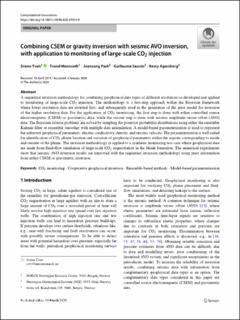Combining CSEM or gravity inversion with seismic AVO inversion, with application to monitoring of large-scale CO2 injection
Peer reviewed, Journal article
Published version
Permanent lenke
https://hdl.handle.net/11250/2650712Utgivelsesdato
2020Metadata
Vis full innførselSamlinger
- NGI articles [1061]
Originalversjon
10.1007/s10596-020-09934-9Sammendrag
A sequential inversion methodology for combining geophysical data types of different resolutions is developed and applied to monitoring of large-scale CO2 injection. The methodology is a two-step approach within the Bayesian framework where lower resolution data are inverted first, and subsequently used in the generation of the prior model for inversion of the higher resolution data. For the application of CO2 monitoring, the first step is done with either controlled source electromagnetic (CSEM) or gravimetric data, while the second step is done with seismic amplitude-versus-offset (AVO) data. The Bayesian inverse problems are solved by sampling the posterior probability distributions using either the ensemble Kalman filter or ensemble smoother with multiple data assimilation. A model-based parameterization is used to represent the unknown geophysical parameters: electric conductivity, density, and seismic velocity. The parameterization is well suited for identification of CO2 plume location and variation of geophysical parameters within the regions corresponding to inside and outside of the plume. The inversion methodology is applied to a synthetic monitoring test case where geophysical data are made from fluid-flow simulation of large-scale CO2 sequestration in the Skade formation. The numerical experiments show that seismic AVO inversion results are improved with the sequential inversion methodology using prior information from either CSEM or gravimetric inversion
